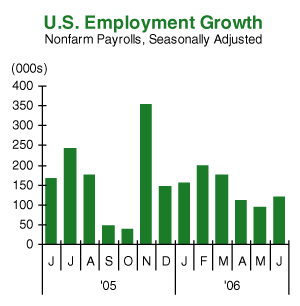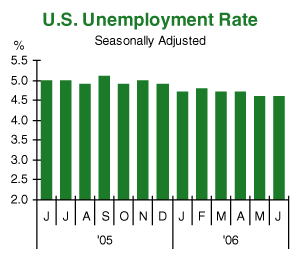|
July 12, 2006
Jobs Conundrum
Written by Jeff Thredgold, CSP, President, Thredgold Economic Associates
During mid-February 2005, Federal Reserve Chairman Alan Greenspan provided his required semi-annual Monetary Policy Report to the Congress. In testimony before the Senate Committee on Banking, Housing, and Urban Affairs, Greenspan used the term “conundrum” to describe the puzzling decline of long-term interest rates of the prior eight months.
He noted that the decline in long-term interest rates had occurred even as the Federal Reserve had pushed its key short-term rate, the federal funds rate, higher by 1.50% from a 46-year low of 1.00% to the then current level of 2.50%. Usage of the word “conundrum” in following weeks and months no doubt resulted in that word being used more than at any other time in history.
Another conundrum is in the Fed’s hands today. This latest puzzle involves the question of 1) whether the Fed should focus on the noticeably slower pace of U.S. job creation of recent months as justification to cease monetary tightening, or 2) whether the Fed should focus on rising wages and overall higher inflation pressures as justification to push its key rate higher for an 18th time on August 8…and perhaps again on September 20 and/or on October 24. 
As we have noted frequently, members of the current Fed, now under Chairman Ben Bernanke, do not know at this time whether they will tighten again on August 8 and/or later. The Fed has made it clear that future monetary policy moves will be increasingly “data dependent”…i.e. that inflation and other economic numbers of coming weeks will help determine what might transpire on August 8 and beyond. Financial markets are also unsure at this point, with market players offering roughly a 50/50 view regarding August 8 tightening at this point.
Mixed Bag
The latest economic data, the June employment report released on July 7, adds to the Fed’s current conundrum. On the surface, the disappointing rise of 121,000 net new jobs in June would argue for a pause or cessation of additional Fed tightening. Financial market players had expected a rise of roughly 180,000 net new jobs.
The June data represented the third consecutive month of job gains coming in below expectations. The average monthly employment rise of 108,000 jobs during 2006’s second quarter was sharply below the 176,000 average pace in the January-March 2006 period. However, the disappointing 121,000 net employment rise in June was overshadowed by other information in the report.
Financial market players were very troubled by the 0.5% rise in the average hourly wage in June. The increase of nine cents to $16.70 hourly was higher than the 0.3% rise expected. In addition, the 3.9% rise over the most recent 12-month period was the largest annual gain in five years.
 Good…and Bad Good…and Bad
On the surface, rising wages are obviously good news to workers. However, rising wages, in part tied to the tightest labor market in five years, sent shivers through Fed officials, who fear that rising wages will soon translate into even higher inflation pressures in coming quarters.
Two other major factors in the report were also of inflation concern to the Fed. The average work week rose 0.1 hours to 33.9 hours. While this change seems trivial, it equates to nearly 400,000 additional jobs created in the economy.
Hammered
One other factor the Fed finds troubling is one we have hammered home constantly in recent years. The “official” employment report, one gleaned from a June survey of 400,000 medium- and large-sized businesses, noted the disappointing 121,000 job rise. Despite the less-than-expected employment gain, the nation’s unemployment rate remained at a five-year low of 4.6%.
Why?…
…because the lesser source of data, that of 60,000 households surveyed in June, and from which the nation’s unemployment rate is derived, showed a powerful gain of 387,000 jobs in June.
Most economy watchers, including me, would agree that the larger survey is more meaningful on a monthly basis. The two surveys historically do move much closer together over an extended period of time…
…except this time
Over the past 60 months, a period of modest economic decline, modest initial recovery, and a more impressive recovery of the most recent 36 months, the “official” business survey notes a net gain of 3,183,000 jobs. The household survey, over the same 60-month period, notes a rise of 7,490,000 net new jobs.
I would continue to argue that this difference of more than 4.3 million jobs represents a greater share of new jobs being created by the expansion of existing small businesses, the creation of new small businesses, more consultants, more contract workers, etc. than ever before. These jobs are simply NOT counted in the business survey and won’t be worked into revised overall employment data for some time to come.
Reasons?
Debate exists within the financial community as to the reason for weaker second quarter job gains. One school of thought suggests the sluggishness of job gains is tied to companies cutting back on job openings as a defensive move against economic slowing, rising short-term interest rates, and sky-high energy prices.
The other school of thought suggests that employment weakness is tied more closely to an overall shortage of available workers, especially those with solid workplace skills. Employers in many communities trying to find available nurses, teachers, truckers, construction workers, natural resource workers, etc. are pulling their collective hair out.
The Fed’s conundrum regarding which economic data to base future monetary moves on is decidedly mixed. However, the Fed does get to see additional critical data in coming weeks, before August 8.
The Fed will see the latest Consumer Price Index data on July 19. The Fed will see the first official estimate of second quarter 2006 GDP growth on July 28. The Fed will also see the latest PCE core rate (the Fed’s favorite inflation measure) on August 1. These pieces of the economic puzzle will hopefully provide some clarity in coming weeks.
Most importantly, the Fed will see the July employment report when it is released on August 4. Perhaps at that time the Fed…and financial market players…will have a less murky…a less “conundrumic” (sorry) view of where future monetary policy needs to be…
…stay tuned

“Tea”ser
People want economy and they will pay any price to get it.
—Lee Iacocca
|

